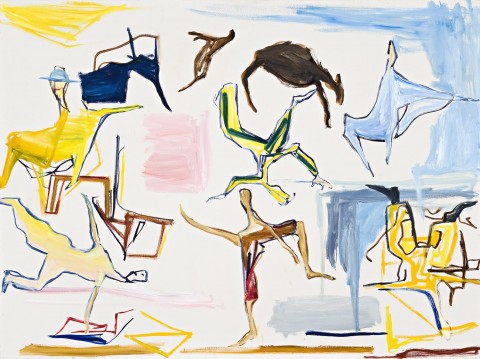DELICATE BALANCE, 1984
KEN WHISSON
oil on canvas
88.5 x 118.5 cm
signed, dated and inscribed verso: (In Bilico) / ‘Delicate Balance’ / 6 / 10 / 84 / Ken Whisson
inscribed canvas edge verso: Touches of yellow etc. / added 11 / 8 / 85 / ‘IN BILICO’ / DELICATE BALANCE / PRECARIOUS BALANCE’ 6 / 10 / 84 [illeg] in fact goes equally well either way Ken Whisson In Bilico’ Delicate Balance 6 / 10 / 84 IN BILICO OR ‘OOPLA’ 6 / 10 / 84
Watters Gallery, Sydney (label attached verso)
Private collection, Sydney
Deutscher~Menzies, Sydney, 4 March 2003, lot 23
Private collection, Sydney
30th Anniversary Summer Exhibition, Watters Gallery, Sydney, 13 – 17 December 1994 and 3 – 28 January 1995, cat. 49
In 1977 Ken Whisson moved to Italy, where he lived and worked until 2017. Italy suited the artist’s temperament, having grown up and spent so long in a conformist Australia, he relished the idea of a country where it was accepted that to live as an artist was quite a normal vocation. A further attraction for Whisson was his interest in global politics and the political shifts which were occurring in Europe at that time – living in Italy allowed him to be closer to the action.
Delicate Balance, 1984, belongs to a group of works which feature circus animals, clowns, jugglers and street performers. Although the series was created in the early 1980s, the imagery harks back to a visit the artist made to Morocco in 1969. In Marrakech, he watched the street circus performance in the town square ’which seemed to go on all day, every day’.1
In an interview with Barbara Blackman Whisson discussed the imagery in the circus paintings: ‘ … I was thinking about atomic war so much, and nuclear war. Europe was very conscious of it because the Geneva Conference was so obviously a farce, so obviously a front for putting new missiles into Europe, and those missiles are so incredibly dangerous … I had the feeling that there wouldn’t be anything to paint anymore, but nuclear annihilation. I took to thinking what a world it might be … what human relations would need to be, if people were going to relate in such a way that they didn’t have to bring about wars … Now that we all live together as an enormous human family across the whole globe, we might need to relate together by entertaining one another. I thought of the world as a great circus’.2
The palette of Delicate Balance is typical of Whisson’s use of bright primary and secondary colours and he presents the forms in a simple, matter of fact way. His basic colour combinations are not dissimilar to those of a sign writer and he uses them with similar intent; he wants his paintings to be noticed, to arrest the viewer’s attention and draw the eye through the narrative in an almost subliminal manner.
Apart from his early works where the influence of Danila Vassilieff and Sidney Nolan is evident, Whisson’s images are totally original. The artist used these early influences as a springboard into his imagination, applied his own ideas about painting and never looked back. His paintings are direct and uncompromising pictures in every way. Perhaps it was Whisson’s choice, to live a humble life devoid of excesses and in a foreign country, which enabled him to create such an unparalleled and consistent body of work over so many decades of dedicated practice.
1. Whisson, K., quoted in Ken Whisson Paintings 1957-1985, Broken Hill City Art Gallery, New South Wales, 1985, p. 19
2. Barbara Blackman, interview with Ken Whisson for National Library of Australia, Oral History Program, 20 April 1984, 2:2
HENRY MULHOLLAND
